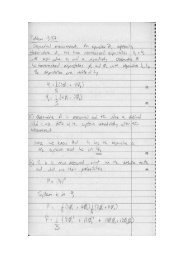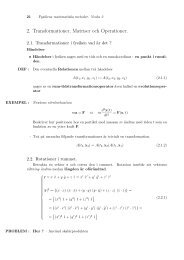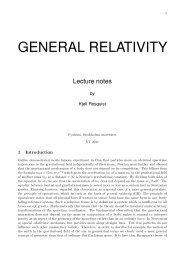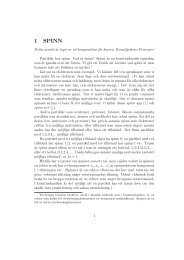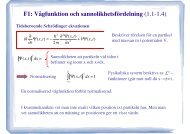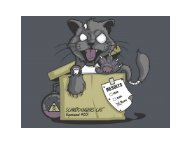Statement of research interests
Statement of research interests
Statement of research interests
Create successful ePaper yourself
Turn your PDF publications into a flip-book with our unique Google optimized e-Paper software.
focus on right now.<br />
We claim that for all the various states discussed above, the thin torus limit is adiabatically<br />
connected to the experimental regime in a similar manner as the free electron gas is connected to<br />
the Fermi liquids in e.g. metals (strong analytical as well as numerical support is given in our<br />
papers).<br />
During the last year we have exploited the somewhat mysterious connection between the<br />
fractional QHE and conformal field theory (CFT), that was pioneered by Moore and Read in the<br />
early 1990's. We have been able to construct explicit microscopic candidate wave functions in<br />
terms CFT correlators for a large set <strong>of</strong> states in the lowest Landau level. The wave functions<br />
obtained by our approach coincide with those due to Laughlin and Jain, whenever these exist and<br />
also yield wave functions describing other fractions. At the newly observed filling fraction, 4/11,<br />
numerics indicate that the trial wave function is indeed correct. Moreover, the Haldane-Halperin<br />
hierarchy, in which the fractionally charged quasiparticles in the vicinity <strong>of</strong> a given filling<br />
fraction condense to form a new groundstate at the new filling, is manifest in our CFT approach.<br />
Thus this provides an explicit connection between the hierarchy and composite fermion<br />
formulations <strong>of</strong> the QHE. We have also established that these wave functions coincide with the<br />
exact ones in the solvable limit (thin torus), and thus provide the adiabatic connection from this<br />
limit to the experimentally accessible regime at the pertinent fractions.<br />
The solvable limit / CFT synthesis has so far resulted in one paper (Phys. Rev. Lett., in press) and<br />
several more are in preparation. We have also published several papers focusing on the solvable<br />
limit (in Phys. Rev. Lett., Phys. Rev. B and J. Stat. Mech.). More details can be found in my CV<br />
and on my homepage: http://www.physto.se/~ejb/ .<br />
Future directions<br />
In the future I would <strong>of</strong> course like to broaden my perspectives and I see the vast and expanding<br />
area <strong>of</strong> quantum information (QI) as a very interesting direction to head towards. In particular, I<br />
am curious about systems where exotic quasiparticles emerge at low energies and their possible<br />
applications to QI. Relevant such phenomena tend to occur in low dimensional systems where<br />
effects <strong>of</strong> interaction and disorder are essential.<br />
Today, there is a lot <strong>of</strong> very interesting progress, experimental as well as theoretical, in this<br />
context. On the experimental side, significant progress is being made in several areas. With the<br />
use <strong>of</strong> optical lattices, environments that were unimaginable only a few years ago can be created.<br />
Possibly, these advances can be exploited to reach the QH regime <strong>of</strong> rotating (Bose-Einstein)<br />
condensates. Even though the particles (atoms) are predicted to be thrown out at precisely the<br />
frequencies needed to enter this regime, there is a chance that an underlying lattice may resolve<br />
these problems. Of course, if this were to be realized we would have a new experimental testing<br />
ground at our hands. Perhaps the very exotic non-abelian (parafermion) states, originally<br />
proposed as candidates for states observed in higher Landau levels in the 2D electron gas, have<br />
their best chance <strong>of</strong> existence in these systems. And <strong>of</strong> course there may be a chance for us<br />
theorists to propose new states <strong>of</strong> matter in this context. As a matter <strong>of</strong> fact, we have come across<br />
a set <strong>of</strong> interesting such states in connection to our CFT project (this is yet unpublished).<br />
As already mentioned, systems supporting non-abelian quasiparticles may arise in different<br />
contexts, most notably in the QH system and/or in rotating atomic condensates. It has been<br />
suggested that these quasiparticles can be used as qbits, thus providing the essential building<br />
blocks <strong>of</strong> a quantum computer. This suggestion has the very appealing feature that it would be



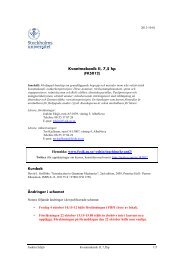
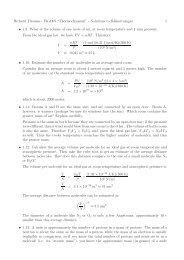
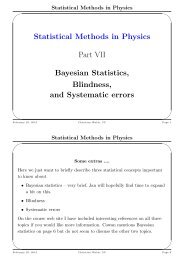
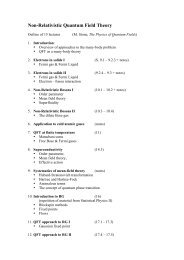
![Final Examination Paper for Electrodynamics-I [Solutions]](https://img.yumpu.com/21085948/1/184x260/final-examination-paper-for-electrodynamics-i-solutions.jpg?quality=85)

